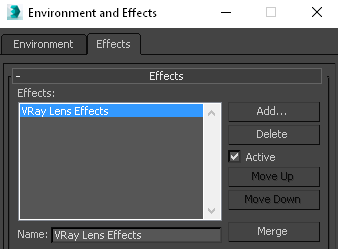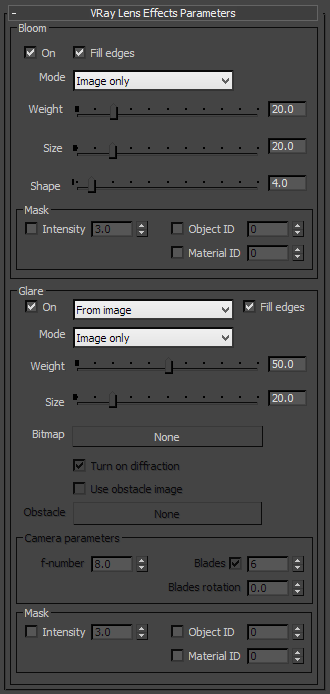Lens Effects | VRayLensEffects
This page gives details on the legacy Lens Effects render effect plugin.
Page Contents
Overview
The VRayLensEffects is used to simulate bloom and glare lens effects by filtering the rendered image with a filter kernel. It uses fast multithreaded technique to compute the result. You can add it from the 3ds Max plugins by choosing Rendering menu > Effects and clicking the Add button and choosing VRay Lens Effects from the list.
Note: VRayLensEffects is provided for compatibility with the 3ds Max Frame Buffer and legacy purposes. There are no plans to update it in the future, so it should not be used for new scenes. It is advised to use the Lens Effects feature in the V-Ray Frame Buffer instead.
UI Path: ||Rendering menu|| > Effects > Environment and Effects window > Effects tab > Effects rollout > Add > VRayLens Effects

Bloom

On – Turns on the bloom lens effect.
Fill edges – When enabled, adds pixel data outside the edges of the original image. This will remove the darkening around the edges.
Mode – Determines if the bloom will be applied to the RGB image, stored in a separate render element, or both. Storing to a render element only works with the V-Ray VFB.
Weight – Specifies the strength of the interpolation between the filtered image and the original image.
Size – Specifies the size of the filter as percentage of the image's width.
Shape – Specifies the falloff of the filter.
Glare
On – Turns on the glare lens effect.
Fill edges – When enabled, adds pixel data outside the edges of the original image. This will remove the darkening around the edges.
Mode – Determines if the glare effect will be applied to the final image, stored into a separate render element, or both. Storing to a render element only works when the V-Ray VFB is enabled.
Glare Type – Specifies how the glare is computed.
From image – Takes the image specified in Bitmap as filter kernel.
From render camera – Takes the necessary parameters from the camera used to perform the rendering and automatically generates the filter kernel.
From camera parameters – Takes the camera parameters specified in the VRayLensEffects render effect itself and automatically generates the filter kernel.
Weight – Specifies the strength of the interpolation between the filtered image and the original image.
Size – Specifies the size of the filter as percentage of the image's width.
Bitmap – Specifies the path to the filter kernel. Available if the Glare Type is set to From image. You can create filters using Filter generator which comes with V-Ray for 3ds Max installation.
Turn on diffraction – When enabled, produces colored patterns in the glare.
Use obstacle image – Enables the use of the obstacle image specified in Obstacle.
Obstacle – Specifies the path to the obstacle image. Available if Use obstacle image is enabled.
Camera Parameters
These parameters are used if the Glare type is set to From camera parameters.
f-number – Specifies the f-number used to calculate the glare. Larger values produce smaller camera aperture and stronger glare effects.
Blades – Controls if the camera aperture has any blades and how many they are. This effect directly controls the rays of the glare.
Blades rotation – Controls the rotation of the of the camera aperture blades.
Mask
The controls in this group allow the user to control where the glare effect will be applied to the image.
Intensity – When enabled, the glare effect will be applied only around pixels that have a value larger than the number specified in the field to the right.
Object ID – When enabled, the glare effect will be applied only to objects with the specified ID.
Material ID – When enabled, the glare effect will be applied only to materials with the specified ID.
Notes
-
When using the V-Ray VFB, VRayLensEffects will be able to handle properly any Color mapping applied to the image by computing the bloom and glare based on actual linear data, and then applying the color mapping to the final result. To achieve this, VRayLensEffects creates internally a render element called LensEffectsSource, which contains the linear colors. When using the 3ds Max frame buffer, this is not possible. In that case, it is recommended to render in linear color space and apply any color mapping as a post-process.